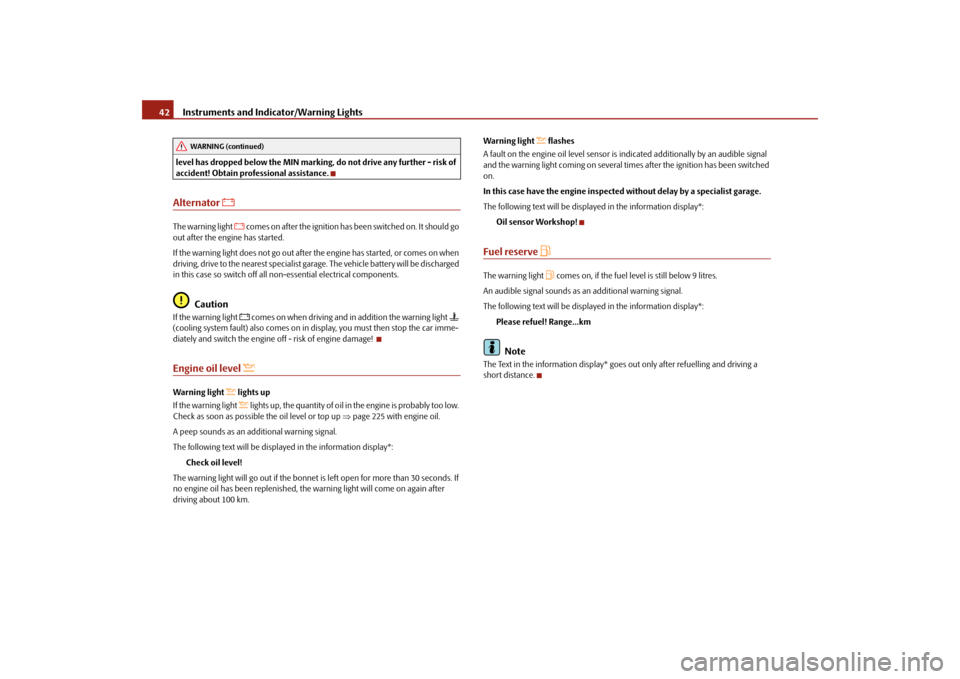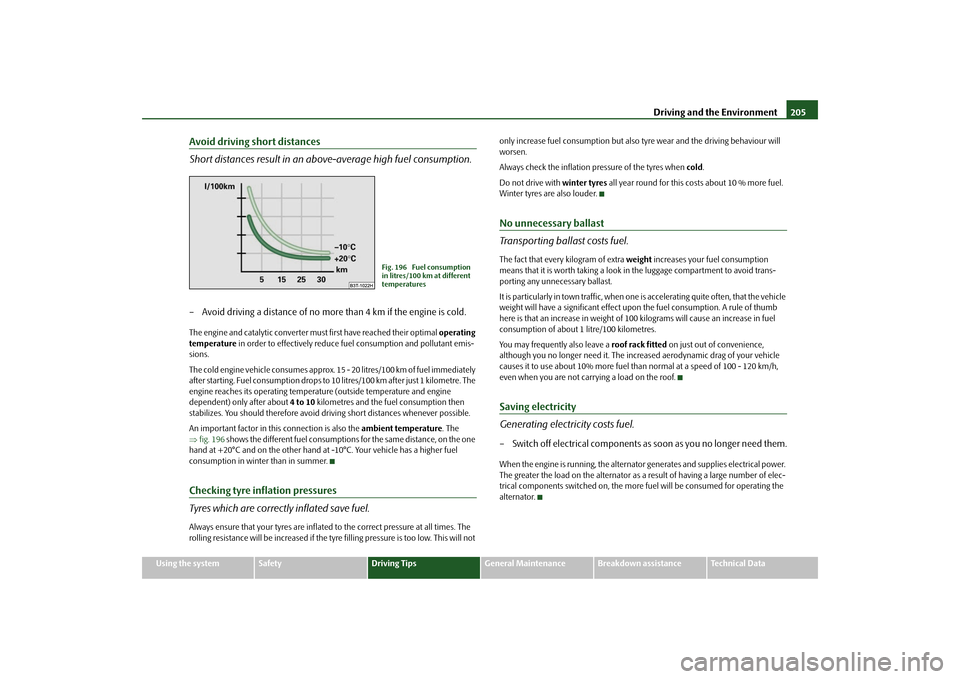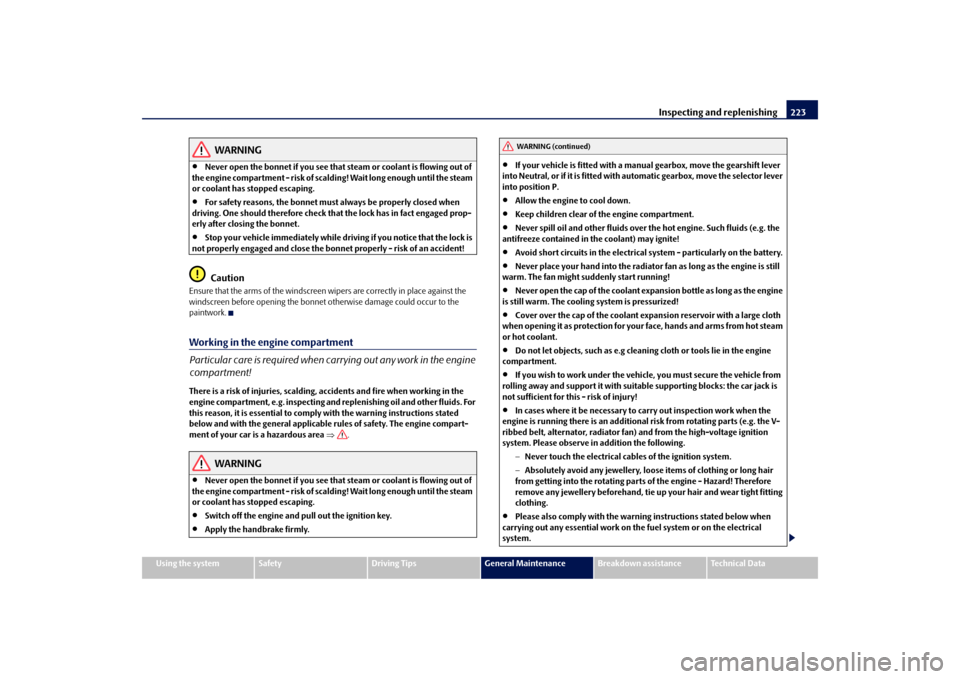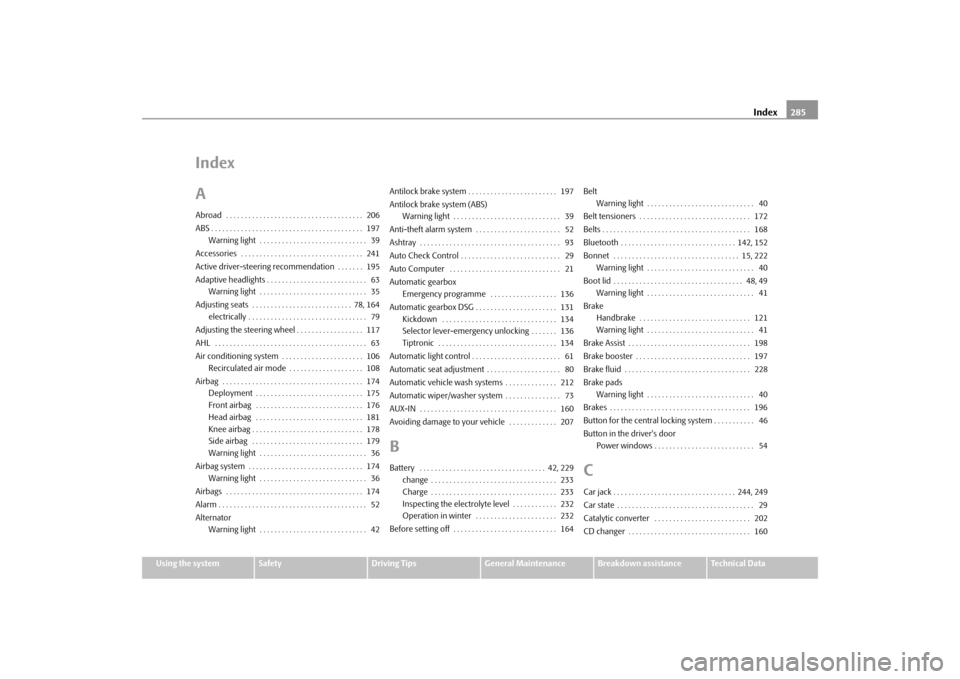alternator SKODA SUPERB 2009 2.G / (B6/3T) Owner's Manual
[x] Cancel search | Manufacturer: SKODA, Model Year: 2009, Model line: SUPERB, Model: SKODA SUPERB 2009 2.G / (B6/3T)Pages: 294, PDF Size: 21.33 MB
Page 43 of 294

Instruments and Indicator/Warning Lights
42
level has dropped below the MIN marking, do not drive any further - risk of accident! Obtain professional assistance.Alternator
The warning light
comes on after the ignition has been switched on. It should go
out after the engine has started. If the warning light does not go out after the engine has started, or comes on when driving, drive to the nearest specialist garage. The vehicle battery will be discharged in this case so switch off all non-essential electrical components.
Caution
If the warning light
comes on when driving and in addition the warning light
(cooling system fault) also comes on in display, you must then stop the car imme- diately and switch the engine
off - risk of engine damage!
Engine oil level
Warning light
lights up
If the warning light
lights up, the quantity of oil in the engine is probably too low.
Check as soon as possible
the oil level or top up
⇒page 225 with engine oil.
A peep sounds as an additional warning signal.The following text will be displayed in the information display*:
Check oil level!
The warning light will go out if the bonnet
is left open for more than 30 seconds. If
no engine oil has been replenished, th
e warning light will come on again after
driving about 100 km.
Warning light
flashes
A fault on the engine oil level sensor is indicated additionally by an audible signal and the warning light coming on several times after the ignition has been switched on. In this case have the engine inspected without delay by a specialist garage.The following text will be displayed in the information display*:
Oil sensor Workshop!
Fuel reserve
The warning light
comes on, if the fuel level is still below 9 litres.
An audible signal sounds as an additional warning signal.The following text will be displayed in the information display*:
Please refuel! Range...kmNote
The Text in the information display* goes out only after refuelling and driving a short distance.
WARNING (continued)
s2dk.1.book Page 42 Wednesday, April 8, 2009 12:23 PM
Page 206 of 294

Driving and the Environment
205
Using the system
Safety
Driving Tips
General Maintenance
Breakdown assistance
Technical Data
Avoid driving short distances Short distances result in an above-average high fuel consumption.– Avoid driving a distance of no more than 4 km if the engine is cold.The engine and catalytic converter mu
st first have reached their optimal
operating
temperature
in order to effectively reduce fu
el consumption and pollutant emis-
sions. The cold engine vehicle consumes approx. 15 - 20 litres/100 km of fuel immediately after starting. Fuel co
nsumption drops to 10 litres/100 km after just 1 kilometre. The
engine reaches its operating temperat
ure (outside temperature and engine
dependent) only after about
4 to 10
kilometres and the fuel consumption then
stabilizes. You should therefore avoid driving short distances whenever possible. An important factor in this connection is also the
ambient temperature
. The
⇒ fig. 196
shows the different fuel consumptions for the same distance, on the one
hand at +20°C and on the other hand at
-10°C. Your vehicle has a higher fuel
consumption in winter than in summer.Checking tyre inflation pressures Tyres which are correctly inflated save fuel.Always ensure that your tyres are inflated
to the correct pressure at all times. The
rolling resistance will be increased if the tyre filling pressure is too low. This will not
only increase fuel consumption but also
tyre wear and the driving behaviour will
worsen. Always check the inflation pressure of the tyres when
cold
.
Do not drive with
winter tyres
all year round for this costs about 10 % more fuel.
Winter tyres are also louder.No unnecessary ballast Transporting ballast costs fuel.The fact that every kilogram of extra
weight
increases your fuel consumption
means that it is worth taking a look in the luggage compartment to avoid trans- porting any unnecessary ballast. It is particularly in town traffic, when one
is accelerating quite often, that the vehicle
weight will have a significant effect upon
the fuel consumption. A rule of thumb
here is that an increase in weight of 100
kilograms will cause an increase in fuel
consumption of about 1
litre/100 kilometres.
You may frequently also leave a
roof rack fitted
on just out of convenience,
although you no longer need it. The incr
eased aerodynamic drag of your vehicle
causes it to use about 10% more fuel th
an normal at a speed of 100 - 120 km/h,
even when you are not carr
ying a load on the roof.
Saving electricity Generating electricity costs fuel.– Switch off electrical components as
soon as you no longer need them.
When the engine is running, the alternator
generates and supplies
electrical power.
The greater the load on the alternator as a result of having a large number of elec-trical components switched on, the more
fuel will be consumed for operating the
alternator.
Fig. 196 Fuel consumption in litres/100 km at different temperatures
s2dk.1.book Page 205 Wednesday, April 8, 2009 12:23 PM
Page 224 of 294

Inspecting and replenishing
223
Using the system
Safety
Driving Tips
General Maintenance
Breakdown assistance
Technical Data
WARNING
•
Never open the bonnet if you see that steam or coolant is flowing out of
the engine compartment - risk of scaldi
ng! Wait long enough until the steam
or coolant has stopped escaping.•
For safety reasons, the bonnet must always be properly closed when
driving. One should therefore check that
the lock has in fact engaged prop-
erly after closing the bonnet.•
Stop your vehicle immediately while driv
ing if you notice that the lock is
not properly engaged and close the bonne
t properly - risk of an accident!
Caution
Ensure that the arms of the windscreen
wipers are correctly
in place against the
windscreen before opening the bonnet otherwise damage could occur to the paintwork.Working in the engine compartment Particular care is required when carrying out any work in the engine compartment!There is a risk of injuries, scalding,
accidents and fire when working in the
engine compartment, e.g. inspecting and replenishing oil and other fluids. For this reason, it is essential to comply with the warning instructions stated below and with the general applicable
rules of safety. The engine compart-
ment of your car is a hazardous area
⇒
.
WARNING
•
Never open the bonnet if you see that steam or coolant is flowing out of
the engine compartment - risk of scaldi
ng! Wait long enough until the steam
or coolant has stopped escaping.•
Switch off the engine and pull out the ignition key.
•
Apply the handbrake firmly.
•
If your vehicle is fitted with a ma
nual gearbox, move the gearshift lever
into Neutral, or if it is fitted with
automatic gearbox, move the selector lever
into position P.•
Allow the engine to cool down.
•
Keep children clear of the engine compartment.
•
Never spill oil and other fluids over the hot engine. Such fluids (e.g. the
antifreeze contained in the coolant) may ignite!•
Avoid short circuits in the electrical system - particularly on the battery.
•
Never place your hand into the radiator fan as long as the engine is still
warm. The fan might suddenly start running!•
Never open the cap of the coolant expa
nsion bottle as long
as the engine
is still warm. The cooling system is pressurized!•
Cover over the cap of the coolant expansion reservoir with a large cloth
when opening it as protection for your
face, hands and arms from hot steam
or hot coolant.•
Do not let objects, such as e.g cleani
ng cloth or tools lie in the engine
compartment.•
If you wish to work under the vehicle, you must secure the vehicle from
rolling away and support it with suitable supporting blocks: the car jack is not sufficient for this - risk of injury!•
In cases where it be necessary to carry out inspection work when the
engine is running there is an additional risk from rotating parts (e.g. the V- ribbed belt, alternator, radiator fan) and from the high-voltage ignition system. Please observe in addition the following.
− Never touch the electrical cabl
es of the ignition system.
− Absolutely avoid any jewellery, loose items of clothing or long hair from getting into the rotating parts of the engine - Hazard! Therefore remove any jewellery beforehand, tie up your hair and wear tight fitting clothing.
•
Please also comply with the warnin
g instructions stated below when
carrying out any essential work on th
e fuel system or on the electrical
system.
WARNING (continued)
s2dk.1.book Page 223 Wednesday, April 8, 2009 12:23 PM
Page 286 of 294

Index285
Using the system
Safety
Driving Tips
General Maintenance
Breakdown assistance
Technical Data
Index
AAbroad . . . . . . . . . . . . . . . . . . . . . . . . . . . . . . . . . . . . . 206
ABS . . . . . . . . . . . . . . . . . . . . . . . . . . . . . . . . . . . . . . . . . 197
Warning light . . . . . . . . . . . . . . . . . . . . . . . . . . . . . 39
Accessories . . . . . . . . . . . . . . . . . . . . . . . . . . . . . . . . . 241
Active driver-steering recommendation . . . . . . . 195
Adaptive headlights . . . . . . . . . . . . . . . . . . . . . . . . . . . 63
Warning light . . . . . . . . . . . . . . . . . . . . . . . . . . . . . 35
Adjusting seats . . . . . . . . . . . . . . . . . . . . . . . . . . . 78, 164
electrically . . . . . . . . . . . . . . . . . . . . . . . . . . . . . . . . 79
Adjusting the steering wheel . . . . . . . . . . . . . . . . . . 117
AHL . . . . . . . . . . . . . . . . . . . . . . . . . . . . . . . . . . . . . . . . . 63
Air conditioning system . . . . . . . . . . . . . . . . . . . . . . 106
Recirculated air mode . . . . . . . . . . . . . . . . . . . . 108
Airbag . . . . . . . . . . . . . . . . . . . . . . . . . . . . . . . . . . . . . . 174
Deployment . . . . . . . . . . . . . . . . . . . . . . . . . . . . . 175
Front airbag . . . . . . . . . . . . . . . . . . . . . . . . . . . . . 176
Head airbag . . . . . . . . . . . . . . . . . . . . . . . . . . . . . 181
Knee airbag . . . . . . . . . . . . . . . . . . . . . . . . . . . . . . 178
Side airbag . . . . . . . . . . . . . . . . . . . . . . . . . . . . . . 179
Warning light . . . . . . . . . . . . . . . . . . . . . . . . . . . . . 36
Airbag system . . . . . . . . . . . . . . . . . . . . . . . . . . . . . . . 174
Warning light . . . . . . . . . . . . . . . . . . . . . . . . . . . . . 36
Airbags . . . . . . . . . . . . . . . . . . . . . . . . . . . . . . . . . . . . . 174
Alarm . . . . . . . . . . . . . . . . . . . . . . . . . . . . . . . . . . . . . . . . 52
Alternator
Warning light . . . . . . . . . . . . . . . . . . . . . . . . . . . . . 42Antilock brake system . . . . . . . . . . . . . . . . . . . . . . . . 197
Antilock brake system (ABS)
Warning light . . . . . . . . . . . . . . . . . . . . . . . . . . . . . 39
Anti-theft alarm system . . . . . . . . . . . . . . . . . . . . . . . 52
Ashtray . . . . . . . . . . . . . . . . . . . . . . . . . . . . . . . . . . . . . . 93
Auto Check Control . . . . . . . . . . . . . . . . . . . . . . . . . . . 29
Auto Computer . . . . . . . . . . . . . . . . . . . . . . . . . . . . . . 21
Automatic gearbox
Emergency programme . . . . . . . . . . . . . . . . . . 136
Automatic gearbox DSG . . . . . . . . . . . . . . . . . . . . . . 131
Kickdown . . . . . . . . . . . . . . . . . . . . . . . . . . . . . . . 134
Selector lever-emergency unlocking . . . . . . . 136
Tiptronic . . . . . . . . . . . . . . . . . . . . . . . . . . . . . . . . 134
Automatic light control . . . . . . . . . . . . . . . . . . . . . . . . 61
Automatic seat adjustment . . . . . . . . . . . . . . . . . . . . 80
Automatic vehicle wash systems . . . . . . . . . . . . . . 212
Automatic wiper/washer system . . . . . . . . . . . . . . . 73
AUX-IN . . . . . . . . . . . . . . . . . . . . . . . . . . . . . . . . . . . . . 160
Avoiding damage to your vehicle . . . . . . . . . . . . . 207
BBattery . . . . . . . . . . . . . . . . . . . . . . . . . . . . . . . . . . 42, 229
change . . . . . . . . . . . . . . . . . . . . . . . . . . . . . . . . . . 233
Charge . . . . . . . . . . . . . . . . . . . . . . . . . . . . . . . . . . 233
Inspecting the electrolyte level . . . . . . . . . . . . 232
Operation in winter . . . . . . . . . . . . . . . . . . . . . . 232
Before setting off . . . . . . . . . . . . . . . . . . . . . . . . . . . . 164Belt
Warning light . . . . . . . . . . . . . . . . . . . . . . . . . . . . . 40
Belt tensioners . . . . . . . . . . . . . . . . . . . . . . . . . . . . . . 172
Belts . . . . . . . . . . . . . . . . . . . . . . . . . . . . . . . . . . . . . . . . 168
Bluetooth . . . . . . . . . . . . . . . . . . . . . . . . . . . . . . . 142, 152
Bonnet . . . . . . . . . . . . . . . . . . . . . . . . . . . . . . . . . . 15, 222
Warning light . . . . . . . . . . . . . . . . . . . . . . . . . . . . . 40
Boot lid . . . . . . . . . . . . . . . . . . . . . . . . . . . . . . . . . . . 48, 49
Warning light . . . . . . . . . . . . . . . . . . . . . . . . . . . . . 41
Brake
Handbrake . . . . . . . . . . . . . . . . . . . . . . . . . . . . . . 121
Warning light . . . . . . . . . . . . . . . . . . . . . . . . . . . . . 41
Brake Assist . . . . . . . . . . . . . . . . . . . . . . . . . . . . . . . . . 198
Brake booster . . . . . . . . . . . . . . . . . . . . . . . . . . . . . . . 197
Brake fluid . . . . . . . . . . . . . . . . . . . . . . . . . . . . . . . . . . 228
Brake pads
Warning light . . . . . . . . . . . . . . . . . . . . . . . . . . . . . 40
Brakes . . . . . . . . . . . . . . . . . . . . . . . . . . . . . . . . . . . . . . 196
Button for the central locking system . . . . . . . . . . . 46
Button in the driver's door
Power windows . . . . . . . . . . . . . . . . . . . . . . . . . . . 54
CCar jack . . . . . . . . . . . . . . . . . . . . . . . . . . . . . . . . . 244, 249
Car state . . . . . . . . . . . . . . . . . . . . . . . . . . . . . . . . . . . . . 29
Catalytic converter . . . . . . . . . . . . . . . . . . . . . . . . . . 202
CD changer . . . . . . . . . . . . . . . . . . . . . . . . . . . . . . . . . 160
s2dk.1.book Page 285 Wednesday, April 8, 2009 12:23 PM